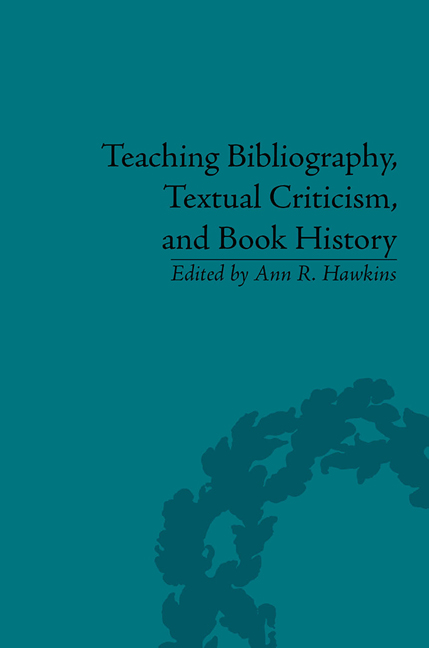Book contents
- Frontmatter
- Contents
- Notes on Contributors
- Foreword
- Introduction: Towards a pedagogy of Bibliography
- Part I Rationales
- Part II Creating and Using Resources
- Book History on the Road: Finding and Organizing Resources Outside the Classroom
- Jane Eyre on eBay: Building a Teaching Collection
- History of the Book in the American Literature Classroom: On the Fly and on the Cheap
- From Printing Type to BlackboardTM: Teaching the History of the Early Modern Book to Literary Undergraduates in a ‘New’ UK University
- Part III Methodologies
- Teaching ‘History of the Book’
- Teaching Bibliography and Research Methods
- Teaching Textual Criticism
- Part V Resources
- Index
From Printing Type to BlackboardTM: Teaching the History of the Early Modern Book to Literary Undergraduates in a ‘New’ UK University
from Part II - Creating and Using Resources
- Frontmatter
- Contents
- Notes on Contributors
- Foreword
- Introduction: Towards a pedagogy of Bibliography
- Part I Rationales
- Part II Creating and Using Resources
- Book History on the Road: Finding and Organizing Resources Outside the Classroom
- Jane Eyre on eBay: Building a Teaching Collection
- History of the Book in the American Literature Classroom: On the Fly and on the Cheap
- From Printing Type to BlackboardTM: Teaching the History of the Early Modern Book to Literary Undergraduates in a ‘New’ UK University
- Part III Methodologies
- Teaching ‘History of the Book’
- Teaching Bibliography and Research Methods
- Teaching Textual Criticism
- Part V Resources
- Index
Summary
I begin with a book and a blindfold. A volunteer – blindfolded – handles a modern book, perhaps a paperback novel or a cookery book. The student is asked to describe the book out loud: to feel it, heft it, listen to it and even smell it. I ask questions: what kind of book do you think it is? what might it be used for? does it feel expensive? is it portable? might it have illustrations? would the type be densely set or spaced out? does it feel important? Though deprived of sight, the student discovers with surprise that he or she can interpret the non-visual signs every book possesses. Nearly always, the student correctly identifies the genre of book with remarkable speed; occasionally, the student offers unexpected, even revealing, insights, as when a copy of the adult hardback edition of the latest Harry Potter was dismissed as cheaply produced.
This activity imitates D.F. McKenzie's famous teaching exercise of handing ‘an utterly blank book’ around his postgraduate class. Through a sequence of questions, McKenzie notes how students identify the book's genre and date with impressive precision. McKenzie concludes: ‘My students already knew more than they thought they did. One had only to make their knowledge conscious.’ These blindfold exercises help students consider what questions to ask of old books and reveal how much latent ‘biblio-kinaesthetic’ knowledge they already have.
The blindfold also provides an apposite metaphor for my teaching experience, particularly the compromises involved in teaching a subject demanding rich resources where those resources are unavailable. This essay has two purposes: ideological, arguing that undergraduate literary students can be taught history of the book, and evangelical, preaching that it can be taught with limited resources and facilities.
- Type
- Chapter
- Information
- Publisher: Pickering & ChattoFirst published in: 2014



